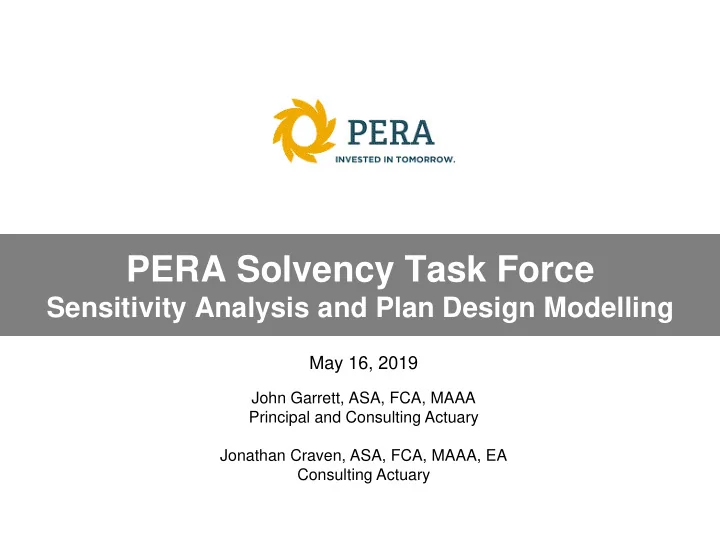

PERA Solvency Task Force Sensitivity Analysis and Plan Design Modelling May 16, 2019 John Garrett, ASA, FCA, MAAA Principal and Consulting Actuary Jonathan Craven, ASA, FCA, MAAA, EA Consulting Actuary
Refresher: Goals of Task Force Prepare and present to the Office of the Governor a set of Recommendations to preserve the defined benefit system offered by PERA by August 30, 2019 Task Force Recommendation must: 1. Result in the July 1, 2019 Unfunded Actuarial Accrued Liability (UAAL) being fully amortized in 25 years or less using an expected investment return assumption of 7.25% 2. Include employer and employee contribution levels and benefit structure that are actuarially sound, preserve the defined benefit retirement and ensure intergenerational equity for all members 3. Consider the funded levels of the Divisions within PERA 2
Deterministic Projections Open-group projections take into account the future membership Deterministic projections assumed all current assumptions are exactly met – Investment gains and losses are primary source of volatility – Deterministic projections use investment returns of 7.25% every future year - no investment gains and losses Indicates the mid-point of future expected outcomes 3
June 30, 2018 PERA Open Group Projection 2018 and 2043 Labeled 90.00% 85.00% 80.00% 75.00% 71.6% 74.4% 70.00% 65.00% 2018 Baseline 4
Vacancy Rate Improvements 5
Reducing Cap on Total Pension Accrual 6
$200m Lump Sum Contribution 7
Employee/Employer Contribution Increases 8
Multiplier Reduction for Tier 1 9
Projected Impact on Net Cash Flow Tier 1 Multiplier Reduction of 0.25% 10
COLAs COLA adjustments can make many different forms. Straight reduction (i.e. from 3% fixed to 2% fixed) Awarded every 3 rd year (i.e. Judges & Magistrates) Risk share, awarded contingent on investment performance and/or funding status Other forms. 11
Stochastic Projections Asset Liability Model – ALM Generates 500 random return outcomes for the next 30 years to model the impact of investment volatility on PERA’s future valuation results Investments are by far the largest source of volatility in future results Provides a range of future outcomes – Median of outcomes or the 50 th percentile – mid-point of expectation – 75 th percentile – best likely outcome – 25 th percentile – worst likely outcome 12
Baseline ALM Output 13
Baseline ALM Output 14
Baseline ALM Output 15
Contribution Increase ALM Output 16
Contribution Increase ALM Output 17
Risk Shared COLA Six (6) states have a risk shared feature to their COLA: Louisiana SERS, Maryland SRPS, Massachusetts SERS and TRB, Nebraska RS, South Dakota RS, Wisconsin RS Instead of automatic fixed COLAs, in a Risk Share COLAs are awarded contingent on investment performance and/or actuarial soundness of the plan. Source: National Association of State Retirement Administrators (NASRA) 18
Considerations for PERA Risk Shared COLA PERA is not fully funded Not all gains are shareable for increased post- retirement benefits so apply funded ratio in determining sharable COLA rates Current retired liability with COLA and 7.25% discount rate is approximately equal to retiree liability without a COLA and a 5.5% discount rate – Spread equals inherent annual annuity adjustment of 1.75% Limit adjustments Avoids potential excessive increases and decreases Model limits COLA adjustments between 0% and 2.5% 19
Risk Shared COLA ALM Output 20
Risk Shared COLA ALM Output 21
Takeaways There is no silver bullet. No one prescription solves funding + negative cash flow challenges alone Improving bad outcome (bottom 25 th percentile investment outcome) cash flow projections should be considered. A balanced combination of prescriptions ought to be considered. 22
Recommend
More recommend